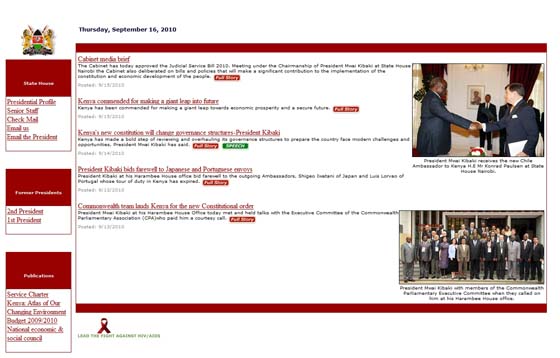I will not mince my words. No. The truth is that most of the Kenyan (even African) web designers who designed (or rather attempted to design!) the sites I often visit have become a disgrace to the profession. They have smeared the art and jumbled up the beautiful poetry that was once called web design. If you doubt my seemingly harsh words, please take a look at our State House web site and compare it to the awesome White House web site! By the way, you know why I had to pick the White House. Apparently, our cousin is the current resident!
I’ll save you the trouble of visiting the sites. Look at the screenshot comparison below.
And now, ladies and gentlemen, gaze upon the White House web site…
Need I say more?! And yet I’m still proud to be Kenyan! (no sarcasm)
Let’s face it… Kenyan web design sucks. Plain and simple. The few good sites that I have seen are largely unaltered premium themes. No one seems to be “creating” anything. How then can it remain a creative field? Has it ever been a creative field, to begin with?
The undesirable effects of this trend are more than you can imagine. It’s a total mess. I’ll soon (TLW) compile a list of the most common mistakes that I see Kenyan web designers making. Today, however, I’ll try and give you a sketchy picture of the web design reality that is as a result of quacks working for big time clients while a few professionals work for clients who have absolutely no inkling of what it takes to design a good web site. This is not comprehensive, and I am prone to being subjective, but what has to be said has to be said.
1. Clients expect extremely cheap quotes
Oftentimes, when clients have asked me to give them a rough estimate of what it will cost to design the web sites they want, my response leaves them looking at me as though I were a Martian. No kidding. I remember a particular incident where a jaw literally dropped! I am assumed to be an extortionist. The most common tactic is then pulled out at this juncture, and it’s almost always the same. “But… You know… There’s this web designer who told me he can do it for only 40K! (Kshs)” Sometimes, I am forced to hit that straight on: “Then why are we here, talking about your site?”
It becomes tricky to try and convincingly explain why CSS layouts are better than tabular ones, or why designs should always start on a sketch pad and not with Dreamweaver 8 (let alone CS5) templates. This, however, would not be an issue if the integrity of the web design profession had been upheld by the majority of the designers themselves.
Kenyans should note that in places like the US, designers are paid per hour! We have a long way to go before that level of professionalism and trust is established. We have to reprove the ‘designers’ who quote peanuts, go download a free template, change the logo and photos in a day or two, then sit around for three weeks to give the impression that they are working hard before they go to collect the cheque. Crazy, huh?
2. Everyone assumes it’s easy
If someone in Kenya were to ask you what you do and you say you are a web designer or developer, they’ll give you as much respect as a form-four leaver who took a course in Microsoft Word. I do not believe that I am the only passionate designer out here. Those of you who feel me know how almost everyone who approaches you starts by saying “I just want a simple web site.” That is usually what precedes a long list of programming and theming back-flips that you have to do to achieve the desired result. Yet it’s still considered ‘simple’! Some even go the proverbial extra mile to let you know that they can do it themselves but they either just don’t have the time or they don’t want to hog work. How amusing!
The right way to approach it is to tell the designer what you want, then he/she get’s to decide whether that is simple or not. If people can do it themselves, they should for instance explain what’s the best way to construct a pagination algorithm in php, and I’ll be convinced.
3. Web site’s users are hardly considered

‘User experience’ is a term that does not exist in the typical Kenyan web designer’s vocabulary.
When the web design and development industry becomes a two way interaction where designers and clients are trying to extract the most out of each other, guess what? The users of the web sites get completely left out of the picture. I personally have to constantly remind myself of this.
‘User experience’ is a term that does not exist in the typical Kenyan web designer’s vocabulary. Either the designer want’s to pay his rent, or the client was told by a friend that they must get something called a web site because it’s good for business. What people forget is that in the same way that you can buy a fully furnished customer care centre, it won’t do you any good if your customers can only stare at it from closed glass doors and windows.
4. Visitors don’t expect much
It’s gotten to a point where even the web site visitors do not expect much from Kenyan web sites. Daima mi ni mkenya, but I particularly loathe the designs of government web sites. Of course, I can openly critique them coz they are mali yetu! Because of the lack of concern for quality and professionalism in web design and development, the kind of sites that we have littered around cyberspace give visitors absolutely no desire to stay or return. Indeed, a disgrace to the profession.
5. A major ‘get rich quick’ attraction
Just a few days ago, I was chatting with a few young men during an event. Somehow within the conversation, the subject of careers came up. I then ventured to ask one of the bespectacled and aloof guys what he wanted to be in life. It went like this:
Huston: What would you like to do?
Dude: Of course, programming!
Huston: Which language?
Dude: All of them! I do all ten.
Huston: (surprised!) All ten? Are they only ten? Even if they were, it’s hard to focus and be proficient in just three!
Dude: I am doing them all. I know Java, HTML, JavaScript…
Huston: O.K then. What is a class?
Dude: Eh… you want a definition?! Eeh… a sub-program.
Huston: What is the latest version of HTML?
Dude: Eh… Dreamweaver 7.
Huston: Ahahahaha! Auwii! Haha!
Dude: (puzzled!)
I have met several such newbies who are self proclaimed gurus. Whether it’s strictly programming or designing, the element of creatively solving problems is indispensable. Along with passion and an unquenchable curiosity and desire to keep growing. Many of the young web designers only seem to do it because they were misinformed by minimal introductions that web sites can be made easily, and that the payoff is good if you land the right jobs.
6. Don’t blame the student?
I have to mention that although the majority of designers are a product of their own desires, there are some honest aspiring ones who have been shortchanged. I was one of them. I attended a well known IT college to do web design. Cost me an arm and a leg! However, what I learnt there was the basic of the most basic training. They taught us how to insert tables and images in Dreamweaver and how to drag links into the document. Period! By the time we finished the course, no one had even been shown how to upload their shoddy site. Had it not been for my constant search in blogs such as Vandelay Design and Smashing Magazine, I would have been as crappy a designer as the ones I now describe here.
The last straw of whatever respect I had for our institutions submerged when I found out during my online search for knowledge that the course book we had used in the college was a FREE e-book, downloadable from the internet. Word for word. Just how muddy can it get?!
Since I’ve been through the same system and in the same boat, I can confidently say that going through sub-standard training is not an excuse for any designer. If you wanna be pro, it’s attainable.
Parting Shot
What do you think about web design in Kenya? East Africa? Africa? Am I just frothing and foaming over unsubstantiated beliefs, or have you experienced the same? For our international visitors, what is the design industry like in your countries?

